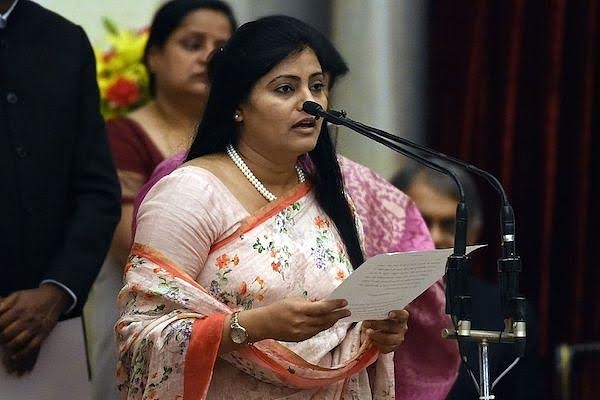Politics
How The Cabinet Reshuffle Will Affect The Uttar Pradesh Elections
- Shifting gears for the upcoming elections, Prime Minister Narendra Modi inducted three more MPs from Uttar Pradesh into his council of ministers on Tuesday.

Getty Images
Shifting gears for the upcoming elections, Prime Minister Narendra Modi inducted three more MPs from Uttar Pradesh into his council of ministers on Tuesday. The induction of Apna Dal’s Anupriya Patel, Krishna Raj and Mahendra Nath Pandey was in keeping with the party’s broader agenda of social engineering. The focus continued to be on other backwards castes, Dalits and eastern Uttar Pradesh.
With the induction of these three, the total number of ministers from UP has gone up to 14. The 15th minister, Ram Shankar Katheria, was dropped. Those making it to the Modi ministry included Apna Dal’s Anupriya Patel (a Kurmi), Krishna Raj (a Pasi) to help take on Mayawati and Mahendra Nath Pandey, a Brahmin. Pandey’s inclusion was done apparently after an overly pro-OBC and Dalit agenda had left the Brahmins quietly miffed.
In the 2014 Lok Sabha elections, the Bharatiya Janata Party had won 71 seats from Uttar Pradesh but only nine of these, including Modi and Rajnath Singh, made it to the Union council of ministers. Others in the original ministry included Kalraj Mishra, Uma Bharti, Maneka Gandhi, Santosh Kumar Gangwar, Sanjeev Kumar Balyan, Gen (retired) VK Singh and Manoj Sinha.
Mahesh Sharma, Sadhvi Niranjan Jyoti and Katheria were included in the November 2014 reshuffle.
The recent inductions have the stamp of the party president Amit Shah and give a glimpse of the BJP’s game plan for Uttar Pradesh, with thrust on the OBCs and Dalits. While it appears that the BJP was unsure of repeating its Lok Sabha performance in the coming elections, that really may not be the case.
The central leadership was aware that if it has to gain power, it must do well in eastern Uttar Pradesh- where it has a negligible presence, besides in other parts of the state. It is, therefore, strategising with the three elements crucial for its success which are eastern Uttar Pradesh, the other backward castes and Dalits.
That Prime Minister Modi and the party president Amit Shah were relying heavily on the OBC vote bank was clear from the inclusion of Anupriya Patel in the ministry, while having Keshav Prasad Maurya as party president. The party may further throw its net wider by giving some responsibility to Rajvir Singh, the son of former UP chief minister and Rajasthan Governor Kalyan Singh, to woo the Lodh voters. Together, they would take care of a large chunk of the OBC vote bank and neutralise the advantage enjoyed by Mulayam Singh Yadav.
When it comes to Dalits, the BJP realises that weaning away Jatavs from Mayawati is difficult. That explains its alliance with the Suheldev Bharatiya Samaj Party, led by Om Prakash Rajbhar and Krishna Raj’s appointment as a minister. Despite these and its other efforts to win over Dalits, and also what looks like Mayawati’s crumbling citadel, the BJP is wary of the Bahujan Samaj Party. With Mayawati attempting to put together a Jatav-Muslim-Brahmin combination, the threat from the BSP is real and potent enough to BJP’s dream of forming a government in UP.
Caste combination apart, the party’s focus is centred on eastern UP. Anupriya Patel represents the Kurmi caste which is influential in parts of Varanasi, Mirzapur, Barabanki, Gonda and other east UP districts. The lawmaker enjoys the support of the only other MP from her party Haribansh Singh. Besides attracting the Kurmi vote bank, Anupriya’s task would be to counter Bihar chief minister Nitish Kumar, also a Kurmi, who is trying to make a foray into UP.
The other minister from eastern UP is Mahendra Nath Pandey, who represents the eastern UP constituency of Chandauli. Krishna Raj, who was elected from Shahjehanpur, belongs to Faizabad.
Eastern UP also has a symbolic significance as Narendra Modi had made the famous “56-inch chest” remark in Gorakhpur while campaigning for the 2014 Lok Sabha elections.
Getting the caste equation right is not the only way BJP will try and win eastern UP. The prime minister is scheduled to visit Gorakhpur where he is expected to announce the revival of the defunct fertiliser factory and setting up of an all-India Institute of Medical Sciences as part of a development package for the poor region.
Still, the social engineering formula enunciated by Modi and Shah may not yield the desired results if issues like Kairana, uniform civil code and triple talaq take precedence over others.
Support Swarajya's 50 Ground Reports Project & Sponsor A Story
Every general election Swarajya does a 50 ground reports project.
Aimed only at serious readers and those who appreciate the nuances of political undercurrents, the project provides a sense of India's electoral landscape. As you know, these reports are produced after considerable investment of travel, time and effort on the ground.
This time too we've kicked off the project in style and have covered over 30 constituencies already. If you're someone who appreciates such work and have enjoyed our coverage please consider sponsoring a ground report for just Rs 2999 to Rs 19,999 - it goes a long way in helping us produce more quality reportage.
You can also back this project by becoming a subscriber for as little as Rs 999 - so do click on this links and choose a plan that suits you and back us.
Click below to contribute.
Latest